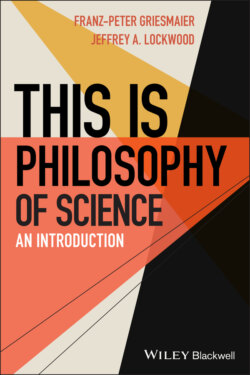Читать книгу This is Philosophy of Science - Franz-Peter Griesmaier - Страница 44
3.3.3 Moving and Burning
ОглавлениеPopper’s conception of empirical science as a process of continual criticism of bold empirical conjectures has been attractive to many working scientists. But is his model of how science grows through criticism borne out by historical evidence? Let’s look at the Polish astronomer Nikolaus Copernicus’ reaction to the problem of stellar parallax and the British chemist Joseph Priestley’s introduction of negative weight.
Suppose you are in a driving car, approaching a city. You happen to look at two tall buildings far ahead on the right side of the road. One of them seems to be almost attached to the other, that’s how close they look to you. However, once your car is driving right past them, you notice that the two buildings are actually dozens of yards apart; of course, as the car continues on its way and you look back, the buildings seem to be closer together again. Something very similar should happen, if heliocentrism is true. As the earth moves around the sun, stars that look to be very close to each other at one point during the year should look to be much farther apart at a later point, at a time when the earth is moving “right past them.” This apparent change in the distance between the stars, as observed from the moving earth, is the phenomenon called “stellar parallax.” The problem was, for Copernicus and his contemporaries, that no stellar parallax had ever been observed! Thus, the opponents of heliocentrism argued that the earth can’t be moving through space and around the sun. To them, the absence of an observable stellar parallax clearly falsified heliocentrism.
In response, Copernicus resorted to the move we discussed earlier: Blame some auxiliary hypothesis! He simply proposed that the absence of an observable stellar parallax is due to the fact that the stars are much further away from us than we thought. If so, then the distance travelled by the earth would be negligible in terms of observing parallax. During his time, most estimates of the size of the universe put the stars, which were thought to be located at the outer edge of the universe, at a distance of about six times that between the earth and the moon (they were off by about one quintillion-fold). In such a small universe, one would expect to observe a stellar parallax. In effect, Copernicus pointed out that to infer that we should observe stellar parallax, two claims need to be true: that the earth moves around the sun and that the universe is sufficiently small. Thus, he was able to blame the assumptions about the size of the universe for the failure to observe stellar parallax. Heliocentrism had not been falsified.
There is another infamous case in which an important scientist tried to save a theory from counterexample, but in which the attempted “rescue mission” led to a rather curious claim. We are thinking of Joseph Priestley, a lifelong defender of the so-called phlogiston theory of combustion. According to this theory, when things burn, they release a very subtle substance, called “phlogiston.” The more phlogiston a material contains, the easier it burns. Given the importance of combustion for chemical experiments, phlogiston was a central concept in early chemistry. In the 1780s, the French chemist Antoine-Laurent de Lavoisier conducted experiments in which he burned mercury. Upon measuring the weight of the residue, he realized that it was heavier than the sample of mercury he started with. This was extremely puzzling: If combustion involves the release of a substance, why should the resulting “ashes” be heavier than the material before it was burned? This fact seemed to conclusively refute the phlogiston theory.
Priestley, however, had an “ingenious” idea to save the theory. Phlogiston, so he claimed, has negative weight. Thus, since phlogiston is released during combustion, the residue will be heavier than the original sample. Of course, since most things that we ordinarily burn, such as wood, also contain water, their ashes will be, all things considered, lighter than what we put into the fireplace, because the water evaporates. Obviously, Priestley made the same move as Copernicus. In order to observe weight loss during combustion, when adjusted for the loss of other components, two things have to be true: phlogiston is released during combustion and phlogiston has positive weight. Thus, he was able to blame the assumption about the weight of phlogiston for the failure to observe weight loss. The phlogiston theory had not been falsified.
